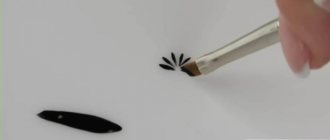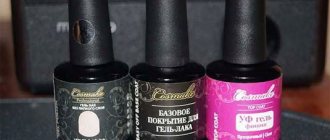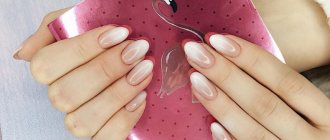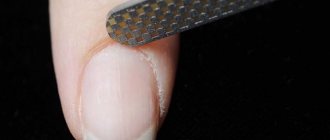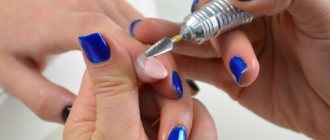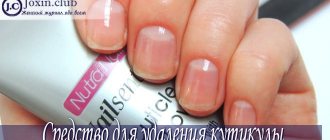Properly selected manicure brushes will help you create a unique, inimitable design - they can be used to apply the finest patterns and fantasy designs, decorate your nails with sparkles and rhinestones, create gradient transitions, and imitate various textures. Using this or that tool, you can bring your wildest ideas and ideas to life. But before you buy a set of professional manicure brushes, you should familiarize yourself with their main types, specific methods of use, and rules for caring for the purchased tools.
Types of manicure brushes
Depending on the material from which they are made, nail design brushes can be:
- natural - from squirrel, kolinsky or sable pile;
- synthetic (nylon);
- mixed - their composition combines synthetics with natural pile.
The most expensive and high-quality brushes are natural ones, but they are quickly spoiled by products containing acetone. In addition, they are difficult to wash off from varnish and gel.
Brushes are also divided according to their purpose:
- for varnish – thinner and longer compared to the “original” brush from the bottle, so they are much more convenient to use;
- for gel – flat square and rectangular, with a fairly hard pile, which makes it easy to model the shape of the nail during extensions;
- for acrylic - round, with long, hard bristles and a pointed tip, onto which it is convenient to sprinkle acrylic powder;
- for design - this includes brushes for drawing, for modeling, fan brushes, for Chinese painting and many others.
Each brush has a number indicating its thickness or width (for flat brushes). The thinnest are marked 00 and 0, the thickest are marked with the number 8, respectively, the larger the number on the handle, the thicker (wider) the instrument.
Nail Spot Brush
To create various designs, special brushes are used for painting on nails, differing in shape, length and bristle stiffness. Thus, the dotting brush has a round shape and short, thin bristles. Its size is the smallest - from 000 to 2. With such brushes it is easy to draw the smallest details of a complex lace pattern or emphasize individual elements.
Fan brush for manicure
A fan brush has bristles directed in all directions, like an open fan. It is convenient for shading floral designs, applying glitter and sparkles: first, the desired area is covered with colorless varnish, and sparkles are carefully scattered on top with a fan brush.
Petal brush for nail design
Thin petal brushes designed for painting nails have a beveled edge and a flat shape. They are convenient for making light strokes, applying glitter, and creating original patterns and ethnic ornaments.
This brush is often used for Chinese painting with characteristic plant motifs - flowers, stems and trees. With a petal brush it is easy to draw specific techniques characteristic of this technique - waves, openwork, smooth surface. The result is a very delicate and romantic design.
brush hair
Hair - a thin brush for nail design, round in shape, often with long bristles. It is very convenient to draw long, straight lines. Depending on the task at hand, you can choose a nail liner brush with bristles of different lengths. Such products are practical and often used by manicurists.
Flat manicure brush
A flat, wide brush allows you to quickly and evenly coat the nail plate with varnish. You can also use it to create a gradient and implement other interesting and non-standard nail art techniques.
Rounded nail brush
A rounded brush with sharp edges is best suited for applying gel polish and sculpting. It is similar in size to a thick brush, but its bristles are oval-shaped. She creates stylish designs of different sizes, for example, flowers, because just one imprint of a rounded brush leaves a perfect petal.
Dagger-shaped manicure brush
Dagger-shaped brushes for nail design are flat, with a smoothly rounded end. They are suitable for simultaneously applying different colors of varnish and drawing elegant, three-dimensional patterns.
Thick manicure brush
A thick brush is suitable for uniformly applying varnish over the entire nail plate, as well as drawing large strokes and wide stripes, processing the contours of large elements and creating three-dimensional patterns. The bristles of thick brushes are straight and flat - this allows you to simultaneously pick up several shades of varnish and draw patterns with multi-colored paint.
Dots
Although dots are actually a stick, they are usually also classified as thin brushes for painting on nails. By applying varnish to the rounded tip of a dot, you can create designs of any complexity - from simple dots to skillful Gzhel painting.
What you need to know about nail design brushes?
To learn how to create beautiful designs on your nails, it is not at all necessary to have professional artistic skills. With the help of a properly selected brush and some experience, you can create beautiful nail art yourself. The choice of a manicure brush depends primarily on the result you want to see on your nails .
Nail design brushes are classified according to the following parameters:
- According to the material.
- According to the thickness and shape of the pile.
Let's take a closer look at each of the categories of brushes, with which you can create designs of any complexity on the surface of your nails.
What brushes are needed for painting on nails?
For beginners taking their first steps in creating nail designs, a basic set of tools consisting of a beveled, rounded and thin brush will help you create simple patterns.
You shouldn’t give in to the temptation and buy everything you can find - first, it’s enough to master the basic techniques of working with two or three tools. There is no need to spend money on expensive brushes made of natural bristles - at first you can safely train with synthetic ones, because they are relatively inexpensive, and besides, the materials with nylon bristles do not flow and are not absorbed. After acquiring the necessary skills, you can move on to professional natural brushes.
Beginners in nail design should take into account the following important nuances:
- a brush made of natural bristles is preferable to use for drawing, while synthetics are ideal for nail extensions when you have to work with dense, viscous substances;
- the shorter the handle, the more comfortable it is to hold the tool;
- It’s more profitable to buy sets, since each brush in it has its own “understudy”.
Unused brushes have a special protective coating, which should be removed after purchase. The stuck together fibers are separated if they are kneaded with circular squeezing movements, after which the bristles should be wiped with a smooth cloth.
Another important procedure is degreasing, which is also recommended to be performed immediately after purchase. A cotton pad is moistened with a special degreaser and used to wipe the villi, carefully separating them. After this, wipe the brush dry with a clean napkin.
What will help solve the problem with choice
With so many options, it's hard to know which design and which brush to use. Photos and videos will help make your choice easier. Specialized sites post information about the brushes used along with the design.
Number of brushes in the set and what types they are
Rounded
Used to apply pigment to the nail. Unlike the standard one, this brush, thanks to its flat tip, makes painting around the cuticle easier and faster. It sort of “fits” into the pocket next to her. The varnish does not flow and is applied in an even layer.
The gel used for nail extensions, smoothes the nail surface and also fits well. A rounded brush is used to decorate the nail. To do this, scoop up a little paint with it, apply pressure, and then during the stroke reduce its force and turn the brush a little on the edge.
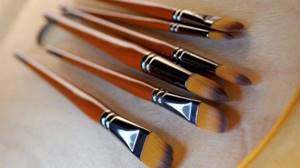
The rounded, short-haired design is ideal for drawing floral and plant elements: just one click is enough to create the perfect petal. Medium-length pile is good for filling the nail plate and modeling. Less common are specimens intended for French. They have an arched dome, with the help of which an arc is easily drawn at the base.
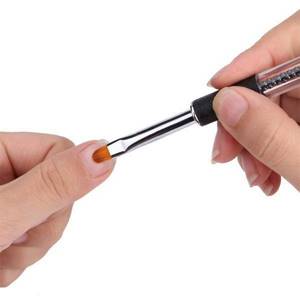
Flat
It is needed for applying powder, glitter, drawing patterns and ombre. For better quality work, it is important to use the application method correctly. You need to dip one side into the varnish and scoop it up a little, then take the brush vertically and, using different pressure forces, make the movement necessary for the pattern.
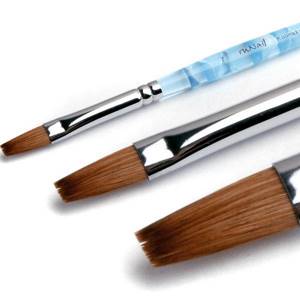
Beveled
One of the easiest to draw. It is important to buy a tool made from natural bristles: this way the paint will stay on it longer, it will apply more softly and cover the entire area. However, using it requires some practice.
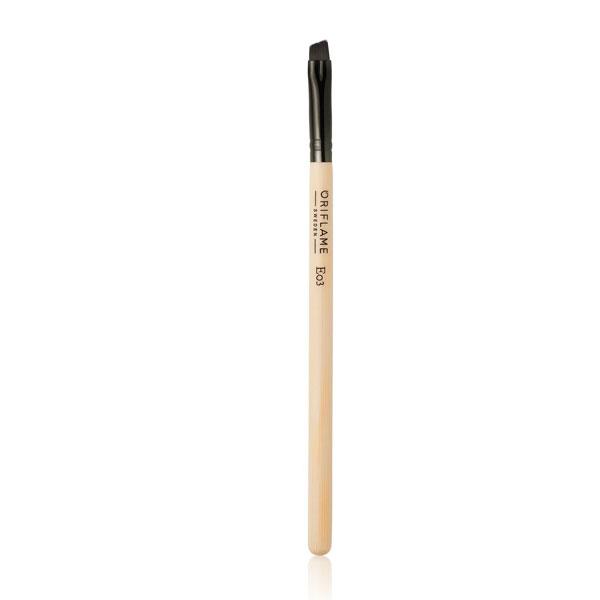
Brush Petal
The special shape of the dome makes it easy and convenient to draw floral patterns, which gave it the name “petal”. It is necessary to dip the tool in acrylic gel paint and, with a brushstroke and pressure, draw an element of the pattern. If you need it in a large size, then the amount of paint should be larger. Calculate so that one dipping is completely enough for one element.

Spot
Used for applying dot elements - the smallest patterns. Paint is applied only to the tip. The brush must be held almost perpendicularly. Depending on the pressure, smaller or larger parts are obtained. Despite the apparent complexity, using the brush is quite simple. After several trainings, it will be able to replace any tools and will become an integral part of the work.

Liner
Also known as hair. They are used to draw straight lines and entire geometric elements. The bunch is completely immersed in the paint and this is done several times.
Depending on the length needed, the liner is placed on the nail with its full surface or only partially. If you take it vertically and draw a line with strong pressure, you can draw a monogram. In this case, paint is applied only to the tip. An angle of 30 degrees will allow you to simply draw intersecting lines that will form a geometric pattern.

The hair is suitable as a tool for creating additional design elements.
Dots
The name is associated with the word “dot”, which corresponds to the main functionality - putting dots. Acts as an auxiliary brush to complement the main design. It is presented in different diameters, the size of the set point depends on this.
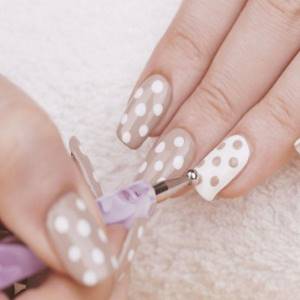
You can use dots to create an entire drawing, to create an abstraction. Even a novice master can easily create a design using dots.
Fan
Fan-shaped is designed to create a gradient effect. This is the easiest way to create a gradient. For gradient manicures, thick varnishes with strong pigment are best suited. This allows you to apply fewer layers, resulting in a thinner nail surface.

Silicone shapers
Used for all types of varnishes: standard, acrylic, gel. Shapers make work convenient and fast. Thanks to them, the varnish is distributed more thinly than when applied with a regular brush. The nozzle does not deform under pressure, so paint sagging or accumulation on the nail is excluded.

It is used to create decorative elements in manicure and apply cosmetic gold. It will not be difficult for even beginners to use.
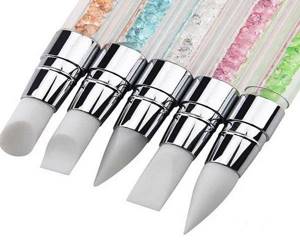
Which brush to apply gel polish with?
A properly selected brush for applying gel polish is the key to a quality job. The result of the work depends on this. You should buy a brush for gel polish, like any other brush for manicure, only in a specialized store - it is advisable to first hold it in your hands, and not just trust the picture on the Internet. It would also be a good idea to read reviews left by other customers. What should you pay attention to when choosing a tool?
How to choose a gel polish brush
When buying a brush for gel polish, first of all, you should evaluate the condition of the bristles - it should be elastic and stiff enough, because it is thanks to rigidity that you can apply the gel perfectly smoothly and correctly model the shape and bend of the nail. The pile must be firmly held in a metal cage, ideally made without a single joint. You should also make sure that the mount fits snugly on both the bristles and the handle.
Brushes for applying gel polish are a universal tool for creating extended manicure. They have different shapes and lengths - here each master is guided by his own taste and sensations.
Attention! When doing nail extensions, you shouldn’t use just one brush; it’s better to get several tools. So, an oval one will help to carefully apply the material along the edges of the nail plate, a beveled one will be convenient for drawing a smile line, and a size 00 nail brush will allow you to carefully draw out small details.
Brushes for applying cosmetics. Which one is needed for what?
Makeup can be done even if there is not a single brush in your arsenal. Use your fingertips to apply foundation, eye shadow and blush. But such a make-up is unlikely to look decent, because one of the main rules of make-up is careful shading. It is perhaps completely impossible to make blurred contours with a fingertip. If your goal is to learn how to apply makeup correctly, quickly and easily, you will have to get brushes.
The shape, length and width, material, level of elasticity or fluffiness of the brush have a direct connection with its purpose. It’s not for nothing that the foundation brush has synthetic, densely collected bristles; often - flat shape. Due to these qualities, it allows you to conveniently apply the cream to your face and distribute it evenly.
Types of Face Makeup Brushes
For the base
As we just explained, foundation brushes are made from synthetic bristles, but why not natural bristles? The fact is that natural hair has scales (similar to human hair), which retain part of the cream. This means that when you transfer the foundation to your face, it will lie with “gap”. Synthetic bristles are more elastic than natural bristles. In addition, the bristles are in close contact with each other, which gives the brush even more elasticity. All these properties do not allow the liquid texture to linger on the brush. Using a special brush, the cream is applied and distributed perfectly, resulting in an even complexion without “gaps” or excess product on the skin.
A more convenient brush has been created for thick foundations. It resembles a kabuki (which will be discussed later), the top of which has been cut off. It's called flat top. This brush is also made of artificial fibers pressed tightly together. Another base brush, which appeared on sale not so long ago, is made in the form of a brush. Its advantage over other types is its comfortable handle.
For concealer
Creamy correctors mask acne, post-acne, and dark circles under the eyes. When applying them to small defects, precision is important, which will be ensured by a special brush - small, flat, tapered at the tip. A concealer brush designed just to cover the under-eye area looks twice as big.
Advice: it is better to choose a smaller brush, as it can be used to carefully paint over small pimples and bruises. With a large brush it is difficult to cover minor imperfections with concealer unnoticed.
For powder
Loose and compact powders are best applied with a fluffy brush with natural bristles - they will not damage the already applied foundation and concealer and will provide light coverage and hold.
Inexpensive powder brushes (which you should avoid) are also fluffy, but they are made from synthetic fiber, which can ruin the creamy texture. The brush is hard, which makes it not very pleasant to touch your face with. Another “minus” of them is the inability to evenly cover the face with powder (there may be too much powder in one area, and not at all in another).
Professional powder brushes are large, fluffy, soft and pleasant to the touch. They can be small (travel options); with a rounded or smooth tip. A popular type of powder brush is the Kabuki. It is very thick and has a short base. This brush is recommended for using mineral makeup. Is it possible to get by with a sponge (or puff), which is included in the set with powder? A sponge will not provide light, uniform coverage. To create high-quality makeup, it is better to use a brush. The sponge is intended for local powdering of the face in those areas where oily shine has appeared (when it is not possible to powder with a brush).
For blush
You can try to blend dry blush with a powder brush. It’s easier for beginners to do this with a special blush brush. The ideal solution is fluffy, natural long pile, slightly beveled. The brush does an excellent job not only of blending blush, but also of darkening cheekbones with bronzer. Professionals prefer kabuki blushes with a beveled or rounded tip.
Blush is often sold complete with a compact brush. Due to its flat shape, it is quite difficult to carefully and evenly apply the product to the cheeks. This brush is only needed to touch up your makeup throughout the day.
How to use manicure brushes
During manicure, the tool must be washed with cold water after each stroke applied, since the acrylic dye dries out very quickly and the design will turn out untidy. But it is not recommended to keep used brushes in water for a long time in the hope that this will clean them better - on the contrary, it will only deform the bristles.
A thin liner brush will last much longer if you use it exclusively for painting with acrylic paints, since nail polish dries out the bristles, making them brittle. After completing the procedure, each brush should be treated with a cleaning liquid. When removing varnish residues from a flat brush, you need to carefully drip the cleaner onto the tool and wipe it several times on a dry cloth with light movements in the direction of the bristles.
Natural and artificial brushes
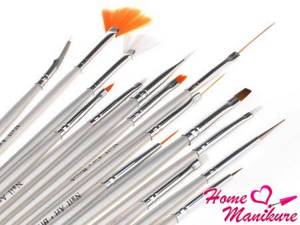
As a rule, natural brushes for painting nails are made from kolinsky or sable wool. Thanks to the excellent quality of the pile, with proper care they will last you quite a long time. With this type of brush you can make designs on your nails using any type of paint.
Synthetic brushes, made from high-quality polymers, are much cheaper than natural ones, but will last you much less. Typically, artificial manicure brushes are the choice of beginner nail art masters who want to learn how to create simple designs on their nails.
How to care for manicure brushes
Manicure brushes should be used exclusively for their intended purpose - they cannot be used to paint on paper, so as not to damage the bristles. If the brush is deformed, you can return it to its proper appearance by holding the tool in hot water for several minutes.
Of course, immediately after completing all the procedures, the brush should be thoroughly washed, removing any remaining varnish - otherwise it will have to be cleaned with acetone, which damages the bristle structure. Also, the bristles wear off very quickly when working with uneven surfaces, so there is no need to be overly zealous when wiping the tool on a napkin. This also applies to the palette for mixing paints - it must be perfectly smooth and even.
Advice! After finishing the procedure, the brush can be softened with cuticle oil.
How to clean a gel polish brush
Proper care of your manicure brushes will extend the life of your favorite tools. Immediately after use, the remaining gel can be removed with a regular napkin; later, the brushes should be cleaned with a special product that removes the dense sticky layer.
If you will be applying gel of different colors, you need to dip the brush into the top coat and also remove any remaining material with a napkin.
Important! Washing gel polish brushes with plain water is strictly prohibited! Also, you should not keep the tools near an ultraviolet lamp, as the remaining paint will immediately dry out and they will be hopelessly damaged.
How to store it correctly
Only cleaned, well-dried tools should be placed in the case - manicure brushes are stored vertically, with the bristles facing up. Also, special caps that are placed, again, on completely dry manicure accessories will help keep the pile in working condition for as long as possible. It is better to store them in a dark, closed place - this way they will not fade, and the microparticles remaining on the surface will not damage the delicate bristles.
Gradient - stylish nail art
“Gradient is my lifelong love. I know 100% that this design is within the power of every master. It looks impressive in a variety of colors. In summer, bright and neon shades are popular. In spring, pastel and delicate. In winter it is deep and cold. And in the fall, the gradient is relevant in warm, muted tones. And it is always relevant for clients.”
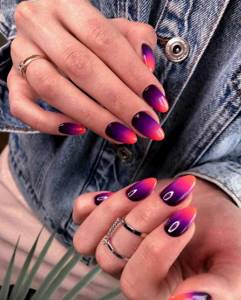
How to make a thin manicure brush
Sometimes you simply don’t have the right tool in your arsenal, but this problem is easy to solve. A thin brush for manicure can be made at home - for this you will need a brush for painting with ordinary paints and sharp tweezers. The bristles should be gradually removed in small tufts from the edges to the center of the fastening. The number of cut fibers depends on the required size of the future instrument.
If you cut a flat watercolor brush diagonally, you get a convenient petal brush. To prevent the remaining bristles from becoming fluffy after trimming, you need to drip top coat onto them and smooth the bristles with your fingers.
How to replace a missing brush?
Covering a nail is only possible if you have the appropriate tools, but when painting a design, there are many life hacks that prevent the lack of a suitable brush from becoming a stopping factor.
So, dots are easy to replace with almost anything: a pen, a toothpick, a cotton swab, a hairpin and other items that you usually have at home.
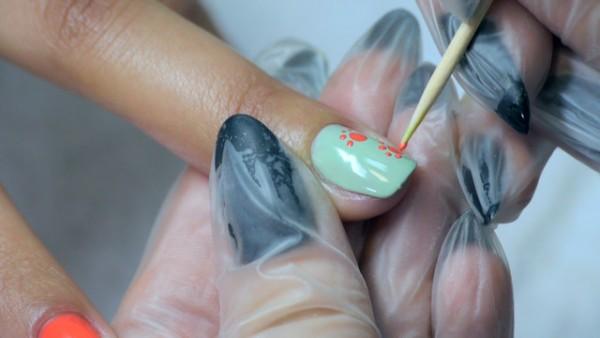
A trimmed pencil eraser turns into a stamp. Just dip the tip in paint and you can apply a leopard print of any color. You can create a line and a geometric pattern using stencils. Special tapes are used. The fan-shaped one can easily be replaced with cosmetic sponges or even a household sponge. The resulting ombre will be indistinguishable.

Manicure is a process that, when choosing the right technique and appropriate tools, becomes quite simple. It is important to know which brush is suitable for certain nail design details and what it is used for. A certain thickness, degree of rigidity and material - all this affects the final result. Only with the right choice and knowledge of the area of application of the brush can you create a high-quality manicure with a beautiful design. Proper instrument care is also important.


